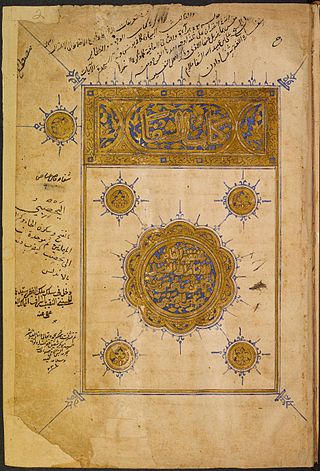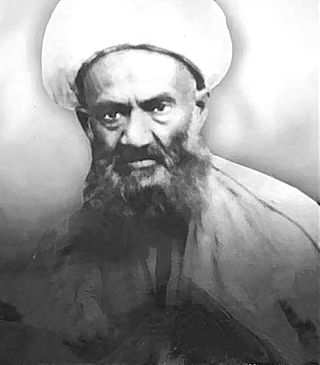Sirat al-Halbiya is a biography of Muhammad by Ali Ibn Burhan-ud-din Halabi (also written as Nur ad-Din al-Halabi or Nuraddin Halabi), an islamic scholar and historian in the 11th century AH.
Sirat al-Halbiya is a biography of Muhammad by Ali Ibn Burhan-ud-din Halabi (also written as Nur ad-Din al-Halabi or Nuraddin Halabi), an islamic scholar and historian in the 11th century AH.
Arabic language names have historically been based on a long naming system. Many people from the Arabic-speaking and also non-Arab Muslim countries have not had given/middle/family names but rather a chain of names. This system remains in use throughout the Arabic and Muslim worlds.
Shams ad-Dīn adh-Dhahabī, also known as Shams ad-Dīn Abū ʿAbdillāh Muḥammad ibn Aḥmad ibn ʿUthmān ibn Qāymāẓ ibn ʿAbdillāh at-Turkumānī al-Fāriqī ad-Dimashqī was an Athari theologian, Islamic historian and Hadith scholar.
Shams al-Dīn Muḥammad ibn Ashraf al-Ḥusaynī al-Samarqandī was a 13th century Persian astronomer and mathematician from Samarkand, now in Uzbekistan.
‘Izz al-Dīn ‘Abu Hamīd ‘Abd al-Hamīd bin Hībat-Allah ibn Abi al-Hadīd al Mutazilī al-Mada'ini, also known as Ibn abi'l-Hadid, was a Shafe'i Mutazili scholar and writer during the Middle Ages. He studied under Abu'l-Khayr Musaddiq ibn Shabib al-Wasiti and is best known for his commentary on the Nahj al-Balagha, which he titled Sharh Nahj al-Balagha.
Jamāl al-Dīn Abū al-Ḥajjāj Yūsuf ibn al-Zakī ʻAbd al-Raḥmān ibn Yūsuf ibn ʻAbd al-Malik ibn Yūsuf al-Kalbī al-Quḍā’ī al-Mizzī,, also called Al-Ḥāfiẓ Abī al-Ḥajjāj, was a Syrian muhaddith and the foremost `Ilm al-rijāl Islamic scholar.

Rayhānah bint Zayd was a Jewish woman from the Banu Nadir tribe, who became a wife of the Islamic prophet Muhammad, after the Invasion of Banu Qurayza in 627 CE. During the battle, she was widowed and taken captive. She is considered by some Muslims as being one of Muhammad's wives.

Al-Shifa bi Ta'rif Huquq al-Mustafa,, of Qadi Ayyad is perhaps the most frequently used and commented upon handbook in which Muhammad's life, his qualities and his miracles are described in every detail. Generally known by its short title, ash-Shifa or al-Shifa, this work was so highly admired throughout the Muslim world that it soon acquired a sanctity of its own, for it is said, "If al-Shifa is found in a house, this house will not suffer any harm... when a sick person reads it or it is recited to him, Allah will restore his health."
Abu Ja'far Muhammad ibn 'Ali ibn Babawayh al-Qummi, commonly referred to as Ibn Babawayh or al-Shaykh al-Saduq was a Persian Shia Islamic scholar whose work, entitled Man La Yahduruhu al-Faqih, forms part of The Four Books of the Shia Hadith collection.
ʿAbd al-Ghanī ibn Ṭālib bin Ḥamāda ibn Ibrāhīm al-Ghunaymī al-Dimashqī al-Maydānī was a jurist (faqīh) and legal theorist (uṣūlī) adhering to the Hanafi school as well as a traditionalist (muḥaddith) and grammarian (naḥwī). Born in 1222 AH in the Maydān neighborhood in southern Damascus, he was known for his vast knowledge and his eagerness to apply it. Just as the neighborhood of his birth still bears this name to this day, he too has become known popularly as al-Maydānī.
The Expedition of Usama bin Zayd was a military expedition of the early Muslim Caliphate led by Usama ibn Zayd that took place in June 632, in which Muslim forces raided Byzantine Syria. The expedition came three years after the Battle of Mu'tah.

Muhammad Ali al-Halabi was a Syrian politician.
Izz al-Din ibn Shaddad al-Halabi (1217–1285) was an Arab scholar and official for the Ayyubids from Aleppo.

Hasan Ali Nukhudaki Isfahani was a Shi'a muslim scholar and Sufi mystic who practiced asceticism. He also studied astronomy and mathematics.
Burhān ad-Dīn Ibrāhīm ibn Muḥammad ibn Ibrāhīm al-Ḥalabī was an Islamic jurist (faqīh) who was born around 1460 in Aleppo, and who died in 1549 in Istanbul. His reputation as one of the most brilliant legists of his time chiefly rests on his work entitled Multaqā al-Abḥur, which became the standard handbook of the Ḥanafī school of Islamic law in the Ottoman Empire.
Abū Bakr az-Zubaydī, also known as Muḥammad ibn al-Ḥasan ibn ‘Abd Allāh ibn Madḥīj al-Faqīh and Muḥammad ibn al-Ḥasan az-Zubaydī al-Ishbīlī, held the title Akhbār al-fuquhā and wrote books on topics including philology, biography, history, philosophy, law, lexicology, and hadith.
Abu al-Walīd Ibn al-Shihna was a Mamluk-era Syrian Hanafi scholar and historian.
Maqṭūʿ or maqṭūʿah is a form of Arabic poetry. Maqāṭīʿ are epigrammatic: brief and generally witty. In the view of Adam Talib, the genre has been underrated by Western scholars, partly because of the low regard for extremely short verse forms in Western traditions.
Ibn Zuhra was a Shiite scholar and captain of the Saddah in Aleppo Faqih, Arabic grammarian, and Mutakallim, He was born in the sixth century AH. And he wrote a book of fiqh called Ghunyatu l-Nuzu and he has emerged by thinkers as Sahib al-Ghunya “.